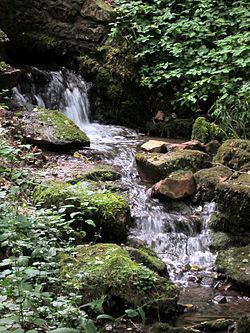Kaskadental (Bad Kissingen)
The Kaskadental is a natural area in the Bavarian spa town of Bad Kissingen in the Lower Franconian district of Bad Kissingen .
Geographical location
The Kaskadental is located in the vicinity of the Bad Kissingen district of Hausen and runs along the state road 2792 , which connects Hausen and Poppenroth (also a district of Bad Kissingen) and leads past the Klaushof wildlife park .
The corner points of the Kaskadental are at the height of the Marieneiche on the state road , which is named after Queen Marie of Hanover, on the one hand and the Altenburger Haus on the outskirts of Hausen on the other.
history
In 1767 the Kaskadental was created in a valley between Hausen and the Bad Kissinger Wildlife Park Klaushof along the course of the Ilgenbach . The water of the Ilgenbach comes from the source of the village well in the nearby Bremersdorf desert .
Prince-Bishop Adam Friedrich von Seinsheim , who would also have liked to have such a facility in his residence in Würzburg , had artificial cascades laid in the course of the Ilgenbach flowing through the valley, as well as sculptures, possibly by the Bad Bockleter court sculptor Ferdinand Tietz, the creator of the figures in the Bad Bocklet spa gardens.
According to the prince-bishop's idea, the purpose of the complex was to please the spa guests. With this in mind, many spa guests from Bad Kissingen and Bad Bocklet met regularly in the Kaskadental .
In 1776, Hofkammerrat Geigel, in his function as saltworks commissioner, had the mortar-free masonry replaced with lime walls, as damage had occurred from ice and floods in the previous winter. In 1778, court fountain master Anton Timmler planted 20 spruce trees in the Kaskadental after the dykes had been broken in two by frost. In the following years, lead pipes were installed in the Kaskadental . Since there was too much earth in the water tank due to the melting of the snow, this was deepened in 1790 under Hofkammerrat Geigel and the walls were made with lime mortar; Furthermore, the fences that were damaged and stolen were supplemented by thorn hedges and new fences.
In 1795, physician and well doctor Dr. Sebastian Goldwitz in his work "The mineral springs of Kissingen and Bocklet in the Franconian court monastery Würzburg" the Kaskadental as a system, in which a path led along numerous and varied water features.
After secularization , the cascade valley began to fall into disrepair and was now exclusively used as a river bed for the Ilgenbach . The whereabouts of the Kaskadental sculptures are now largely unknown; the torso of one of the sculptures is now in the Altenburg house .
On July 10, 1866, acts of war between Bavarian and Prussian troops took place around the Kaskadental and especially at the Altenburger Haus as part of the German War of 1866. The Prussian Lieutenant Robert Delius, wounded by Bavarian bullets, died in Altenburg's house ; his tomb is at the memorial for the fallen for 1866 . As part of a commemoration held in the Altenburg house in 1891 by several student bodies to commemorate the war events, the students honored the present Chancellor Otto von Bismarck with a performance of the song Die Wacht am Rhein .
Web links
literature
- Past cascades. In: Peter Ziegler: Celebrities on promenade paths. Emperors, kings, artists, spa guests in Bad Kissingen. Verlag Ferdinand Schöningh, Würzburg 2004, ISBN 3-87717-809-X , pp. 170-173.
- The creator of the Cascade Valley. In: Werner Eberth : Contributions to the history of Hausen and Kleinbrach. Volume 2. Theresienbrunnen-Verlag, Bad Kissingen 2010, p. 57f.
Individual evidence
- ^ Peter Ziegler: Celebrities on promenade paths - emperors, kings, artists, spa guests in Bad Kissingen , Verlag Ferdinand Schöningh, 2004, ISBN 3-87717-809-X , pp. 171–172
- ^ Peter Ziegler: Prominence on promenade paths - emperors, kings, artists, spa guests in Bad Kissingen , Verlag Ferdinand Schöningh, 2004, ISBN 3-87717-809-X , p. 171
- ^ Peter Ziegler: Prominence on promenade paths - emperors, kings, artists, spa guests in Bad Kissingen , Verlag Ferdinand Schöningh, 2004, ISBN 3-87717-809-X , pp. 172-173
- ^ Elisabeth Keller: Die Flurdenkmale im Landkreis Bad Kissingen , Volume 1, self-published by the Landkreis Bad Kissingen, 1978
- ^ Denis André Chevalley, Stefan Gerlach: City of Bad Kissingen (= Bavarian State Office for Monument Preservation [Hrsg.]: Monuments in Bavaria . Volume VI.75 / 2 ). Karl M. Lipp Verlag, Munich 1998, ISBN 3-87490-577-2 , p. 140 .
- ^ Werner Eberth : Michael Arnold. A sculptor of the late classicism . Theresienbrunnen-Verlag, Bad Kissingen 2001, pp. 60–61
- ↑ Werner Eberth: Contributions to the history of Hausen and Kleinbrach , Volume 3. Theresienbrunnen-Verlag, Bad Kissingen 2011, pp. 139–148
- ↑ Werner Eberth: The German War of 1866 in the Bad Kissingen district , Theresienbrunnen-Verlag Bad Kissingen, 2016, p. 176
- ↑ Peter Ziegler: Celebrities on promenade paths - emperors, kings, artists, spa guests in Bad Kissingen , Verlag Ferdinand Schöningh, 2004, ISBN 3-87717-809-X , p. 173
- ^ Werner Eberth: Bismarck and Bad Kissingen . Theresienbrunnen-Verlag, Bad Kissingen 1998, pp. 305-318
Coordinates: 50 ° 13 '25.7 " N , 10 ° 3' 27.3" E

